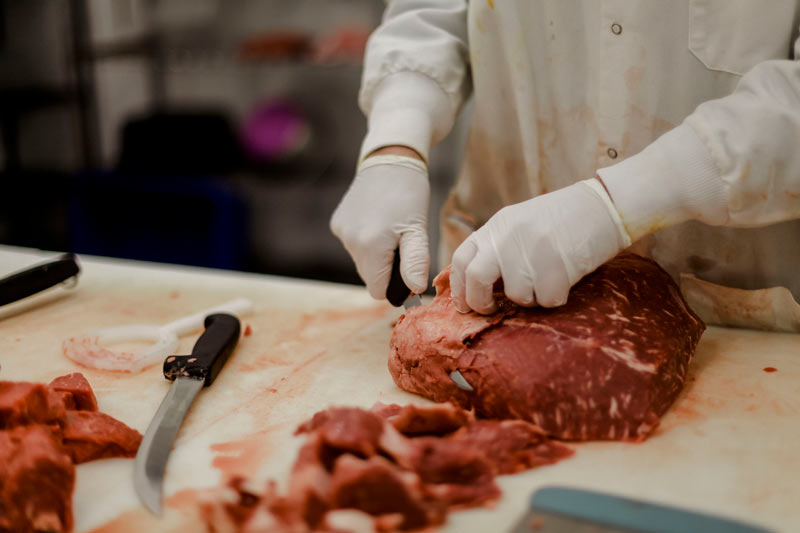Why Citizens Love Bagley Farms Meat Market Edwardsville IL for Their Meat Buying
Why Citizens Love Bagley Farms Meat Market Edwardsville IL for Their Meat Buying
Blog Article
Discover the Art of the Butcher's Cut in a Modern Meat Market
In the ever-evolving landscape of contemporary meat markets, the butcher's cut has actually transcended its typical roots, combining old-time workmanship with modern methods. What really establishes the modern butcher apart is their capability to create a much deeper link between customers and the origins of their meat.
Evolution of Butchery Methods

The mid-20th century saw butchery techniques better refined by scientific insights right into muscular tissue biology and meat aging, boosting both inflammation and preference. Advancements like vacuum packaging and refrigeration prolonged product shelf-life, allowing butchers to diversify offerings and improve quality assurance. This period also marked the rise of specific equipment, such as band saws and meat slicers, which increased precision and effectiveness in meat handling.
Computerized systems currently help in monitoring pet provenance and enhancing cuts to meet certain consumer choices. In addition, a renewal in artisanal butchery has actually emerged, mixing conventional abilities with modern-day expertise to provide to customers seeking moral and lasting meat alternatives.

Recognizing Meat Cuts

Understanding the ins and outs of meat cuts is essential for both butchers and customers looking for quality and value. For butchers, exact cuts show skill and regard for the craft, guaranteeing minimal waste and ideal yield.
The primary classifications of meat cuts consist of primitive, sub-primal, and retail cuts. Butchers then damage these down additionally right into sub-primal cuts, prior to ultimately producing retail cuts offered to consumers, like ribeye or tenderloin.
Understanding muscular tissue structure is vital; muscle mass made use of much more frequently by the animal have a tendency to be harder and are best suited for slow-moving cooking methods, while less-used muscular tissues, like those located in the loin, are much more tender and suitable for barbecuing or roasting. Experience with these distinctions encourages consumers to make educated choices, boosting their culinary ventures.
Picking Quality Meat
Choosing the appropriate meat includes greater than simply choosing an aesthetically attractive item from the screen. The art of picking top quality meat needs a discerning eye and knowledge of specific characteristics that symbolize freshness and excellence. Pay focus to the color; beef ought to have a brilliant, cherry-red tone, while lamb ought to exhibit a soft pink tone, and pork a light pink. This shows the meat is fresh and hasn't been subjected to oxygen for as well lengthy.
Secondly, consider the marbling, which refers to the white flecks of fat within the muscular tissue. Correct marbling is a vital indicator of tenderness and flavor, as it melts throughout cooking, improving the meat's juiciness. Keep in mind, higher marbling commonly correlates with premium quality cuts, such as USDA Prime.
Appearance is an additional critical factor; meat ought to feel strong to the touch, not slimed or excessively soft. Additionally, be mindful of the fragrance. Fresh meat should have a tidy, neutral smell, devoid of any kind of sour or repulsive smells.
Coupling Cuts With Cooking Approaches
Successfully matching cuts of meat with the suitable food preparation approaches is vital for attaining optimum taste and structure. These approaches improve the meat's all-natural i thought about this flavors and make certain a juicy finish.
Conversely, tougher cuts like brisket and chuck roast are abundant in collagen, which breaks down into jelly when cooked gradually. These cuts are excellent for braising or sluggish roasting, permitting the meat to soften gradually and establish deep, complicated flavors. Likewise, cuts such as brief ribs and pork shoulder make out well with slow-cooking techniques, where expanded cooking times change their robust textures into succulent dishes.
Lamb shanks and oxtail, which need long term cooking to tenderize, are best candidates for stewing or sluggish simmering. These methods coax out rich, hearty tastes while keeping dampness. By understanding the unique attributes of each cut, cooks and home chefs alike can raise their cooking productions, making sure each recipe is click to read more both pleasing and memorable.
The Butcher's Duty Today
Navigating the evolving landscape of the contemporary meat market, the butcher's duty today extends past simple preparation of cuts. Contemporary butchers are culinary craftsmens, instructors, and advocates for lasting techniques. They connect the gap in between the farm and the fork by making sure moral sourcing, understanding pet husbandry, and prioritizing openness in the supply chain. This shift shows the expanding customer demand for quality over amount, where provenance and pet well-being are vital.
In addition to crafting precise cuts, butchers now engage directly with customers, providing cooking advice and tailoring choices to match private needs and choices. Their experience in meat aging, marbling, and taste accounts encourages consumers to make enlightened decisions, improving their culinary experiences. This customized solution exhibits the butcher's progressing duty as a trusted advisor in the kitchen.
In addition, butchers are essential in reducing waste, utilizing whole pets to create diverse items such as sausages and supplies - bagley farms meat market edwardsville il. This comprehensive strategy not only appreciates the pet however also lines up with contemporary sustainability goals. In this means, the modern-day butcher symbolizes both custom and development, adjusting to an ever-changing market while maintaining the artistry and integrity of their craft

Verdict
Mastery in comprehending diverse meat cuts and quality indicators equips butchers to give informed referrals, aligning particular cuts with optimal food preparation techniques. useful reference By recognizing historic practices while welcoming contemporary demands, the butcher's duty continues to be crucial in today's innovative meat market.
Report this page